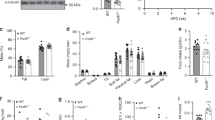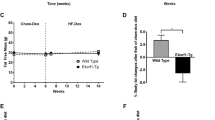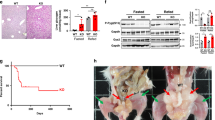Abstract
Unsuppressed hepatic glucose production (HGP) contributes substantially to glucose intolerance and diabetes, which can be modeled by the genetic inactivation of hepatic insulin receptor substrate 1 (Irs1) and Irs2 (LDKO mice). We previously showed that glucose intolerance in LDKO mice is resolved by hepatic inactivation of the transcription factor FoxO1 (that is, LTKO mice)—even though the liver remains insensitive to insulin. Here, we report that insulin sensitivity in the white adipose tissue of LDKO mice is also impaired but is restored in LTKO mice in conjunction with normal suppression of HGP by insulin. To establish the mechanism by which white adipose tissue insulin signaling and HGP was regulated by hepatic FoxO1, we identified putative hepatokines—including excess follistatin (Fst)—that were dysregulated in LDKO mice but normalized in LTKO mice. Knockdown of hepatic Fst in the LDKO mouse liver restored glucose tolerance, white adipose tissue insulin signaling and the suppression of HGP by insulin; however, the expression of Fst in the liver of healthy LTKO mice had the opposite effect. Of potential clinical significance, knockdown of Fst also improved glucose tolerance in high-fat-fed obese mice, and the level of serum Fst was reduced in parallel with glycated hemoglobin in obese individuals with diabetes who underwent therapeutic gastric bypass surgery. We conclude that Fst is a pathological hepatokine that might be targeted for diabetes therapy during hepatic insulin resistance.
This is a preview of subscription content, access via your institution
Access options
Access Nature and 54 other Nature Portfolio journals
Get Nature+, our best-value online-access subscription
$29.99 / 30 days
cancel any time
Subscribe to this journal
Receive 12 print issues and online access
$209.00 per year
only $17.42 per issue
Buy this article
- Purchase on Springer Link
- Instant access to full article PDF
Prices may be subject to local taxes which are calculated during checkout






Similar content being viewed by others
Change history
15 August 2018
In the version originally published, many graphs contained units that were formatted inconsistently. The units have been reformatted for consistency throughout the figures. Some units in the Supplementary Information were also updated to correct inconsistent formatting. Additionally, a line erroneously appeared under “GFP” in Fig. 2i, and the “RYGB” labels in Fig. 2h,i were not horizontally aligned. The line has been removed and the labels properly aligned. This article now appears correctly.
References
Perry, R. J. et al. Hepatic acetyl CoA links adipose tissue inflammation to hepatic insulin resistance and type 2 diabetes. Cell 160, 745-758 (2015).
Jin, X., Moskophidis, D. & Mivechi, N. F. Heat shock transcription factor 1 is a key determinant of HCC development by regulating hepatic steatosis and metabolic syndrome. Cell Metab. 14, 91–103 (2011).
Samuel, V. T. & Shulman, G. I. The pathogenesis of insulin resistance: integrating signaling pathways and substrate flux. J. Clin. Invest. 126, 12–22 (2016).
Husted, A. S., Trauelsen, M., Rudenko, O., Hjorth, S. A. & Schwartz, T. W. GPCR-mediated signaling of metabolites. Cell Metab. 25, 777–796 (2017).
Stefan, N. & Haring, H. U. The metabolically benign and malignant fatty liver. Diabetes 60, 2011–2017 (2011).
El Ouaamari, A. et al. SerpinB1 promotes pancreatic β cell proliferation. Cell Metab. 23, 194–205 (2016).
Biddinger, S. B. & Kahn, C. R. From mice to men: insights into the insulin resistance syndromes. Annu. Rev. Physiol. 68, 123–158 (2006).
Edgerton, D. S. et al. Insulin’s direct hepatic effect explains the inhibition of glucose production caused by insulin secretion. JCI Insight 2, e91863 (2017).
Meyer, C. et al. Renal substrate exchange and gluconeogenesis in normal postabsorptive humans. Am. J. Physiol. Endocrinol. Metab. 282, E428–E434 (2002).
White, M. F. & Copps, K. in Endocrinology Vol. 1 (eds Jameson, J. L. & DeGroot, L. J.) 556–585 (Elsevier, Philadelphia, PA, 2016).
Titchenell, P. M., Lazar, M. A. & Birnbaum, M. J. Unraveling the regulation of hepatic metabolism by insulin. Trends Endocrinol. Metab. 28, 497–505 (2017).
Dong, X. C. et al. Inactivation of hepatic FoxO1 by insulin signaling is required for adaptive nutrient homeostasis and endocrine growth regulation. Cell Metab. 8, 65–76 (2008).
Cheng, Z. et al. FoxO1 integrates insulin signaling with mitochondrial function in the liver. Nat. Med. 15, 1307–1311 (2009).
Guo, S. et al. The Irs1 branch of the insulin signaling cascade plays a dominant role in hepatic nutrient homeostasis. Mol. Cell Biol. 29, 5070–5083 (2009).
O’Sullivan, I. et al. FoxO1 integrates direct and indirect effects of insulin on hepatic glucose production and glucose utilization. Nat. Commun. 6, 7079 (2015).
Lu, M. et al. Insulin regulates liver metabolism in vivo in the absence of hepatic Akt and FoxO1. Nat. Med. 18, 388–395 (2012).
Titchenell, P.M. et al. Direct hepatocyte insulin signaling is required for lipogenesis but is dispensable for the suppression of glucose production. Cell Metab. 23, 1154-1166 (2016).
Titchenell, P. M., Chu, Q., Monks, B. R. & Birnbaum, M. J. Hepatic insulin signalling is dispensable for suppression of glucose output by insulin in vivo. Nat. Commun. 6, 7078 (2015).
Stefan, N. & Haring, H. U. The role of hepatokines in metabolism. Nat. Rev. Endocrinol. 9, 144–152 (2013).
Han, H. Q., Zhou, X., Mitch, W. E. & Goldberg, A. L. Myostatin/activin pathway antagonism: molecular basis and therapeutic potential. Int. J. Biochem. Cell Biol. 45, 2333–2347 (2013).
Hansen, J. S. & Plomgaard, P. Circulating follistatin in relation to energy metabolism. Mol. Cell. Endocrinol. 433, 87–93 (2016).
Bluher, M. et al. Adipose tissue selective insulin receptor knockout protects against obesity and obesity-related glucose intolerance. Dev. Cell 3, 25–38 (2002).
Shearin, A. L., Monks, B. R., Seale, P. & Birnbaum, M. J. Lack of AKT in adipocytes causes severe lipodystrophy. Mol. Metab. 5, 472–479 (2016).
Wang, Z. et al. Inhibition of TNF-α improves the bladder dysfunction that is associated with type 2 diabetes. Diabetes 61, 2134–2145 (2012).
Hansen, J. S. et al. Circulating follistatin is liver-derived and regulated by the glucagon-to-insulin ratio. J. Clin. Endocrinol. Metab. 101, 550–560 (2016).
Hansen, J. et al. Plasma follistatin is elevated in patients with type 2 diabetes: relationship to hyperglycemia, hyperinsulinemia, and systemic low-grade inflammation. Diabetes Metab. Res. Rev. 29, 463–472 (2013).
Brown, M. L. & Schneyer, A. L. Emerging roles for the TGFβ family in pancreatic β-cell homeostasis. Trends Endocrinol. Metab. 21, 441–448 (2010).
Kucejova, B. et al. Hepatic mTORC1 opposes impaired insulin action to control mitochondrial metabolism in obesity. Cell Rep. 16, 508–519 (2016).
Wallace, T. M., Levy, J. C. & Matthews, D. R. Use and abuse of HOMA modeling. Diabetes Care 27, 1487–1495 (2004).
Walton, R. G. et al. Increasing adipocyte lipoprotein lipase improves glucose metabolism in high fat diet-induced obesity. J. Biol. Chem. 290, 11547–11556 (2015).
Kim, J. K. et al. Tissue-specific overexpression of lipoprotein lipase causes tissue-specific insulin resistance. Proc. Natl Acad. Sci. USA 98, 7522–7527 (2001).
Zhang, W. et al. Integrated regulation of hepatic lipid and glucose metabolism by adipose triacylglycerol lipase and FoxO proteins. Cell Rep. 15, 349–359 (2016).
Schneyer, A. L., Wang, Q., Sidis, Y. & Sluss, P. M. Differential distribution of follistatin isoforms: application of a new FS315-specific immunoassay. J. Clin. Endocrinol. Metab. 89, 5067–5075 (2004).
Brown, M. L. et al. Follistatin and follistatin like-3 differentially regulate adiposity and glucose homeostasis. Obesity 19, 1940–1949 (2011).
Ueno, N. et al. Isolation and partial characterization of follistatin: a single-chain Mr 35,000 monomeric protein that inhibits the release of follicle-stimulating hormone. Proc. Natl Acad. Sci. USA 84, 8282–8286 (1987).
Samanta, D. & Datta, P. K. Alterations in the Smad pathway in human cancers. Front. Biosci. (Landmark Ed.) 17, 1281–1293 (2012).
Shi, Y. & Massague, J. Mechanisms of TGF-β signaling from cell membrane to the nucleus. Cell 113, 685–700 (2003).
Massague, J. TGFβ signalling in context. Nat. Rev. Mol. Cell Biol. 13, 616–630 (2012).
Sidis, Y. et al. Biological activity of follistatin isoforms and follistatin-like-3 is dependent on differential cell surface binding and specificity for activin, myostatin, and bone morphogenetic proteins. Endocrinology 147, 3586–3597 (2006).
Lambert-Messerlian, G. M. et al. Inhibins and activins in human fetal abnormalities. Mol. Cell. Endocrinol. 225, 101–108 (2004).
Mukherjee, A. et al. FSTL3 deletion reveals roles for TGF-β family ligands in glucose and fat homeostasis in adults. Proc. Natl Acad. Sci. USA 104, 1348–1353 (2007).
Guo, T. et al. Adipocyte ALK7 links nutrient overload to catecholamine resistance in obesity. eLife 3, e03245 (2014).
Modica, S. et al. Bmp4 promotes a brown to white-like adipocyte shift. Cell Rep. 16, 2243–2258 (2016).
Wang, Q., Guo, T., Portas, J. & McPherron, A. C. A soluble activin receptor type IIB does not improve blood glucose in streptozotocin-treated mice. Int. J. Biol. Sci. 11, 199–208 (2015).
Hansen, J. S. et al. Exercise-induced secretion of FGF21 and follistatin are blocked by pancreatic clamp and impaired in type 2 diabetes. J. Clin. Endocrinol. Metab. 101, 2816–2825 (2016).
Ferre, P., Leturque, A., Burnol, A. F., Penicaud, L. & Girard, J. A method to quantify glucose utilization in vivo in skeletal muscle and white adipose tissue of the anaesthetized rat. Biochem. J. 228, 103–110 (1985).
Hancer, N. J. et al. Insulin and metabolic stress stimulate multisite serine/threonine phosphorylation of insulin receptor substrate 1 and inhibit tyrosine phosphorylation. J. Biol. Chem. 289, 12467–12484 (2014).
Copps, K. D., Hancer, N. J., Qiu, W. & White, M. F. Serine 302 phosphorylation of mouse insulin receptor substrate 1 (Irs1) is dispensable for normal insulin signaling and feedback regulation by hepatic S6 kinase. J. Biol. Chem. 291, 8602–8617 (2016).
Zhu, A., Romero, R. & Petty, H. R. An enzymatic fluorimetric assay for glucose-6-phosphate: application in an in vitro Warburg-like effect. Anal. Biochem. 388, 97–101 (2009).
Tao, R. et al. Hepatic FoxOs regulate lipid metabolism via modulation of expression of the nicotinamide phosphoribosyltransferase gene. J. Biol. Chem. 286, 14681–14690 (2011).
Xiong, X., Tao, R., DePinho, R. A. & Dong, X. C. Deletion of hepatic Foxo1/3/4 genes in mice significantly impacts on glucose metabolism through downregulation of gluconeogenesis and upregulation of glycolysis. PLoS ONE 8, e74340 (2013).
Myburgh, R. et al. Optimization of critical hairpin features allows miRNA-based gene knockdown upon single-copy transduction. Mol. Ther. Nucleic Acids 3, e207 (2014).
Miao, J. et al. Functional specificities of Brm and Brg-1 Swi/Snf ATPases in the feedback regulation of hepatic bile acid biosynthesis. Mol. Cell. Biol. 29, 6170–6181 (2009).
Shang, Y., Hu, X., DiRenzo, J., Lazar, M. A. & Brown, M. Cofactor dynamics and sufficiency in estrogen receptor-regulated transcription. Cell 103, 843–852 (2000).
Acknowledgements
We thank S. Biddinger’s lab for providing the cDNA from the LIRKO liver. We thank E. Rosen’s lab for providing the 3T3-L1 cells. We thank U. Ozcan’s lab for providing the pAAV2.TBG.PI vector. We thank R. DePinho’s lab for providing the floxed FoxO1 mice. This work was supported by NIH grants DK098655 and project 2 GM021700 (M.F.W.); DK108642 (N.S.); and DK091592, DK107682 and AA024550 (X.C.D.).
Author information
Authors and Affiliations
Contributions
M.F.W. and R.T. designed the research direction. R.T. performed the majority of the experiments with specialized assistance from C.W., K.D.C., O.S., W.Q., Y.H., J.M., S.L., X.C.D., L.L., M.S. and N.S. All data were analyzed by R.T. and M.F.W. The manuscript was written by R.T. and M.F.W. with assistance from K.D.C.
Corresponding author
Ethics declarations
Competing interests
M.F.W. is a scientific consultant for Housey Pharmaceutical Research Laboratories.
Additional information
Publisher’s note: Springer Nature remains neutral with regard to jurisdictional claims in published maps and institutional affiliations.
Supplementary information
Supplementary Text and Figures
Supplementary Figures 1–12 and Supplementary Tables 1–6
Rights and permissions
About this article
Cite this article
Tao, R., Wang, C., Stöhr, O. et al. Inactivating hepatic follistatin alleviates hyperglycemia. Nat Med 24, 1058–1069 (2018). https://doi.org/10.1038/s41591-018-0048-0
Received:
Accepted:
Published:
Issue Date:
DOI: https://doi.org/10.1038/s41591-018-0048-0
This article is cited by
-
Endocrinology for the Hepatologist
Current Hepatology Reports (2024)
-
Circulating follistatin as a novel biomarker of type 2 diabetes mellitus risk
International Journal of Diabetes in Developing Countries (2023)
-
Upregulation of WDR6 drives hepatic de novo lipogenesis in insulin resistance in mice
Nature Metabolism (2023)
-
Depletion of CD206+ M2-like macrophages induces fibro-adipogenic progenitors activation and muscle regeneration
Nature Communications (2022)
-
Exerkines in health, resilience and disease
Nature Reviews Endocrinology (2022)



